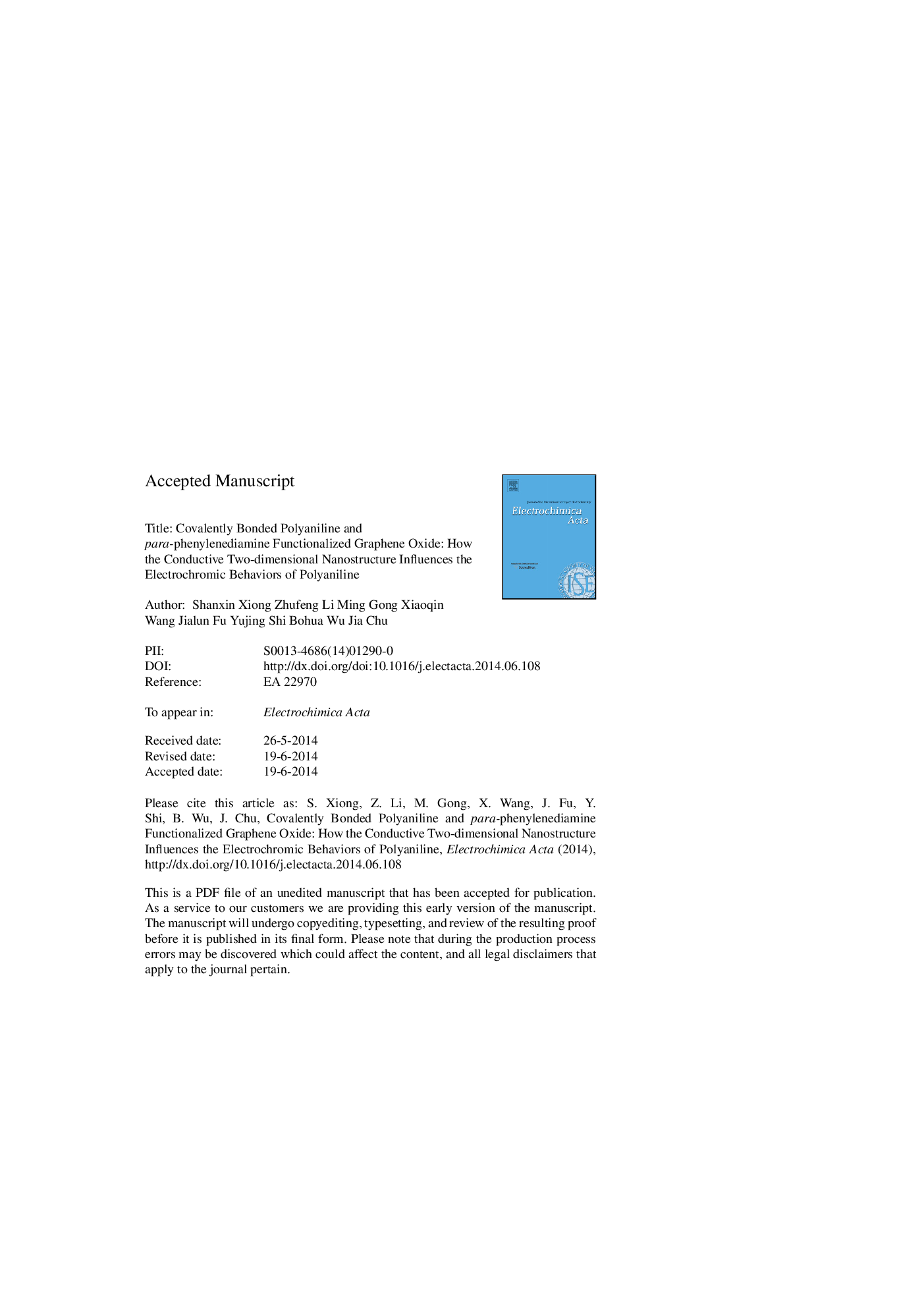| کد مقاله | کد نشریه | سال انتشار | مقاله انگلیسی | نسخه تمام متن |
|---|---|---|---|---|
| 6613218 | 459595 | 2014 | 42 صفحه PDF | دانلود رایگان |
عنوان انگلیسی مقاله ISI
Covalently Bonded Polyaniline and para-phenylenediamine Functionalized Graphene Oxide: How the Conductive Two-dimensional Nanostructure Influences the Electrochromic Behaviors of Polyaniline
ترجمه فارسی عنوان
پلی وینیلین و پارا فینیلندایامین متشکل از پلی وینیل پروتئین دی اکسید گرافین کارآمد: نحوه ساختار نانوساختار دو بعدی تاثیر گذار رفتار الکتروشیمی پلیانیلین
دانلود مقاله + سفارش ترجمه
دانلود مقاله ISI انگلیسی
رایگان برای ایرانیان
کلمات کلیدی
موضوعات مرتبط
مهندسی و علوم پایه
مهندسی شیمی
مهندسی شیمی (عمومی)
چکیده انگلیسی
Polyaniline (PANI) was attached onto the reduced graphene oxide (rGO) sheets through copolymerization of aniline with a para-phenylenediamine (PPD) functionalized graphene oxide (GO-PPD) using the poly(styrene sulfonate) (PSS) as the macromolecular dopant agent to produce a water-dispersible electrochromic material. The structures and the morphologies analysis confirm that the final electrochromic materials (rGO-PANI) are the mixture of PANI/PSS and the covalently bonded rGO-PANI (rGO-PANI hybrid). The rGO-PANI hybrid can be found to form a parallel arrangement to the substrate in the spin-coated film. This parallel arrangement of the layered two-dimensional nanostructure of rGO-PANI hybrid may narrow the ion transportation pathways of the exchanged ions, which will result in a high charge transfer resistance and slow switching speed. Meanwhile, with the conductive rGO added, the electrical conductivity of the electrochromic layer will be increased, which will benefit to low charge transfer resistance and high optical contrast. So the conductive two-dimensional nanostructure has a double-face influence on the electrochromic performances of PANI, which include a positive influence on the electrical conductivity and a negative influence on the ion diffusion. The overall influences depend on the loading amount of GO-PPD. With 4Â wt.% GO-PPD feeding, the optical contrast was enhanced by 36% from 0.38 for PANI/PSS to 0.52 for rGO-PANI-3, while the coloration time was almost same as that of PANI/PSS and the bleaching time was decreased by â¼20% from 9.1s for PANI/PSS to 7.4s for rGO-PANI-3. The electrochemical tests showed that with the increasing of GO-PPD loading, the peak currents of cyclic voltammetry (CV) curves were increased, and the peak locations shifted to the positive potential for oxidation peak and the negative potential for reduction peak, respectively, which confirmed that the double-face influences of rGO-PANI on the electrochromic properties, including the enhanced electrochemical activities and the declined kinetic process.
ناشر
Database: Elsevier - ScienceDirect (ساینس دایرکت)
Journal: Electrochimica Acta - Volume 138, 20 August 2014, Pages 101-108
Journal: Electrochimica Acta - Volume 138, 20 August 2014, Pages 101-108
نویسندگان
Shanxin Xiong, Zhufeng Li, Ming Gong, Xiaoqin Wang, Jialun Fu, Yujing Shi, Bohua Wu, Jia Chu,
